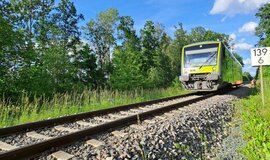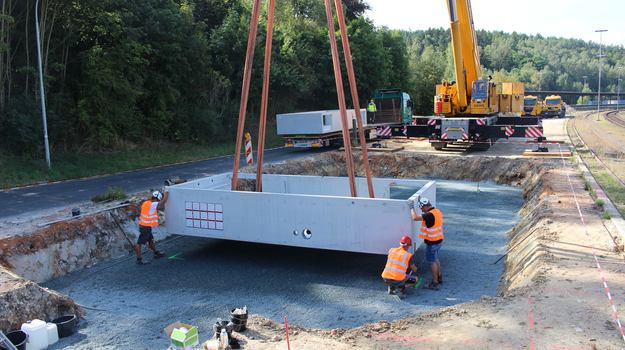
For a modern rail network in Europe: From Marktredwitz in Bavaria to the Czech Republic
Digitale Schiene Deutschland (DSD) is digitising the railway line from Marktredwitz in Bavaria to the Czech Republic: Following extensive planning, construction work for the installation of a modern electronic interlocking (Elektronisches Stellwerk: ESTW) will begin in Schirnding in August. The section of line between Arzberg and the Czech border will then be equipped with the standardised European Train Control System (ETCS). In this interview, the responsible project manager Alexander Serdyuk explains the construction measures planned in detail and what the conversion and digitalisation of the technology means for the region and European train traffic.
Mr Serdyuk, after an intensive planning phase, the so-called "Czech border crossing: Schirnding - Marktredwitz" project is now entering the construction phase. What will now be realised on the route between Marktredwitz via Arzberg and Schirnding to the Czech border?

In the upcoming construction phase, we are digitising the existing control and safety technology (LST) and upgrading to the modern and Europe-wide standardised European Train Control System (ETCS). ETCS is the train control system that will replace the different train control systems in Europe. Every country has at least one, and Germany even has two train control systems in the form of point-based train control (PZB) and line-based train control (LZB).
Before the ETCS equipment is installed, however, the existing control and safety technology must be modernised so that it meets the technical requirements for the ETCS equipment. This also includes upgrading the old relay interlocking in Schirnding. In order to make the line fit for ETCS, we are building a modern electronic interlocking (ESTW) here. This will be the first step in the construction work.
How long will the construction work take and what does the remaining work look like in detail?
We will start constructing the modular building for the ESTW in Schirnding in August. We are renewing three level crossings along the route, laying 87 kilometres of cable and replacing 47 signals and 18 point machines. We will then equip eight kilometres of the line with ETCS. Among other things, around 250 balises will be laid on the tracks to transmit data to the train. These transmit, for example, information on the exact localisation of the train. Full commissioning of the line is planned for the end of next year.
You develop new technologies in the project together with the Czech Republic: What exactly are these development services?
Together with our Czech colleagues, we are developing new and joint interlocking and ETCS technologies between the two countries. Strictly speaking, this involves the joint development of compatible block technology and the joint development and initial application of an ETCS-guided transition between the two countries. In future, both passenger and goods trains from Germany will be able to switch from the German PZB train control system to the European ETCS before crossing the border and continue their journey seamlessly in the Czech Republic. The reverse is also possible, of course. This simplifies train traffic considerably. Future projects between Germany and the Czech Republic will also benefit from these technical developments.
What impact will the project have on passengers and travellers?
By digitising the railway line, we are increasing the reliability and punctuality of our trains and optimising cross-border rail transport. In practical terms, we are making a significant contribution to a modern, digital rail network in Europe on the border between Germany and the Czech Republic.
Click here for the official press release on the start of construction in Schirnding (German only).
